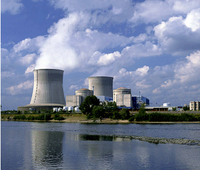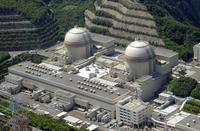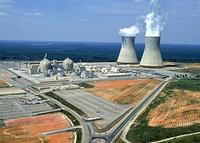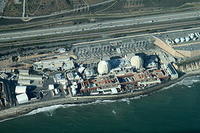-
New reactor design makes nuclear power competitive with natural gas

San Diego-based General Atomics has applied for funding of several hundred millions from the U.S Department of Energy to commercialize a nuclear reactor which, the firm claims, could cut the cost of nuclear power by as much as 40 percent. The new design replaces water with helium as a coolant, allowing the plant to operate at higher temperatures, thus increasing the efficiency of the power plan and reducing the amount of waste needing storage.
-
-
Long-term radiation effects: Chernobyl’s lessons for Fukushima
The Fukushima Daiichi nuclear disaster spread significant radioactive contamination over more than 3,500 square miles of the Japanese mainland in the spring of 2011. Now several recently published studies of Chernobyl are bringing a new focus on just how extensive the long-term effects on Japanese wildlife might be.
-
-
U.S. nuclear reactors vulnerable to terrorist attack: study
More than ten years after the 9/11 hijackers considered flying a fully loaded passenger jet into a Manhattan area nuclear reactor, U.S. commercial and research nuclear facilities remain inadequately protected against two credible terrorist threats — the theft of bomb-grade material to make a nuclear weapon, and sabotage attacks intended to cause a reactor meltdown. A new report finds that none of the 104 commercial nuclear power reactors in the United States is adequately protected — but among the most vulnerable are eleven reactors in California, Connecticut, Florida, Maryland, Massachusetts, Missouri, New York, North Carolina, Texas, and Virginia. One of these reactors, on the grounds of the National Institute of Standards and Technology (NIST), is among the three research reactors fueled with bomb-grade uranium, and is located in the Washington, D.C. suburb of Gaithersburg, less than twenty-five miles from the White House.
-
-
U.S. nuclear facilities vulnerable to terrorist attack: study

Some U.S. nuclear facilities are inadequately protected against theft of weapons-grade materials and sabotage by terrorists. Terrorist attacks on vulnerable nuclear facilities could trigger a meltdown or lead to a diversion of bomb-grade uranium. The danger is far from hypothetical since the 9/11 hijackers are known to have considered flying a passenger jet into a U.S. nuclear reactor before they settled on the World Trade Center as their main terror target.
-
-
Virtual nuke control room helps nuclear operators, industry
Modernizing nuclear power plants to help extend their operating lifetimes is no small task. The endeavor offers an opportunity to improve control-room design and layout. The Department of Energy’s new Human System Simulation Laboratory (HSSL) at Idaho National Laboratory (INL) is a full-scale virtual nuclear control room that can test the safety and reliability of proposed technology replacements before they are implemented in commercial nuclear control rooms. The facility is now helping Duke Energy embark on an upgrade project for several of its nuclear plant control rooms.
-
-
Mini-nuclear power plants may pull the nuclear industry out of a tight spot
Supporters of nuclear powers argue that mini-nuclear power plants offer the best hope for a struggling industry. These plants produce less energy, but they cost less, will be faster to build, and have less potential for a disaster.
-
-
Nuclear academics, professionals meet for 6th annual ATR NSUF Users Week
The sixth annual Advanced Test Reactor National Scientific User Facility (ATR NSUF) Users Week was held 10-14 June at University Place, the satellite campus for Idaho State University and University of Idaho in Idaho Falls. This nuclear research-themed week was the user facility’s opportunity to update the user community on nuclear energy issues and tools, conduct a research forum where users can come and present their research, run specialized workshops, and build collaboration among academic, industry and government institutions.
-
-
Japan to restart nuclear power plants

Japan’s fifty nuclear power plants were taken off-line in the wake of the 2011 Fukushima nuclear disaster, but the government Prime Minister Shinzo Abe, which took office in December, said it was planning to restart Japan’s nuclear power generation program.
-
-
Georgia’s Plant Vogtle may determine future of nuclear energy

Analysts say that the future of the U.S. nuclear industry, and of nuclear power generation in the United States, will largely depend on the success of two reactors, called Vogtle 3 and 4, at the Alvin Vogtle nuclear power plant in Georgia. For the nuclear industry, the Plant Vogtle project and another project in South Carolina may be the last hope of what many analysts consider to be a dying energy source.
-
-
Understanding next-generation nuclear fuel
The long search for the location of a rare element within nuclear fuel particles has ended. Researchers have finally pinpointed where silver congregates inside irradiated particles of a new type of nuclear fuel. The finding will help scientists better understand how select fission products such as silver can escape from tristructural isotropic (TRISO) fuel. This specialized fuel could run high-temperature gas-cooled reactors (HTGRs) that have numerous enhanced safety features.
-
-
California’s San Onofre nuclear power plant retired due to safety concerns

Southern California Edison (SCE) has decided it will retire the San Onofre nuclear power plant located on the California coast. The decision comes after officials debated for over a year whether the twin reactors could be safely restarted. The power plant is located in a populated area, with millions living near it.
-
-
Fukushima-derived radioactivity in seafood poses minimal health risks
Researchers find that the likely doses of radioactivity ingested by humans consuming fish contaminated by radioactive radiation escaping from the debilitated Fukushima reactors fish, are comparable to, or less than, the radiological dosages associated with other commonly consumed foods, many medical treatments, air travel, and other background sources.
-
-
A “cauldron of events” has brought the nuclear industry to a halt
Until two years ago, people talked of a nuclear energy renaissance. Now the talk is about nuclear malaise. The Fukushima scare, the emergence of alternative energy sources as a result of fracking, and the lack of action on climate change – which means that limits on fossil fuels are not coming any time soon – have, in the words of one experts, brought the nuclear industry to a halt.
-
-
Reducing the volume of nuclear waste
The nuclear industry seeks to minimize the volume of nuclear waste by extracting the radioactive elements from spent fuel.This relies on exploiting differences in the chemical bonding of uranium. Scientists have found that in some circumstances the bonding may be surprisingly similar, an important discovery which is going to be important in the amelioration of nuclear waste clean-up and devising new atom-efficient catalytic cycles.
-
-
U.S., South Korea delay nuclear fuel deal
The president of South Korea, Park Geun-Hye, has been campaigning to get the United States to lift the ban on South Korea from enriching uranium and processing spent nuclear fuel. The ban was part of a 1972 treaty, which was set to expire next March. A deal appeared to be on the way at some point this year, but officials from both countries said the deadline would be extended to 2016. What did not help the negotiations were statements by some South Korean officials that the country should build its own nuclear weapons reather than rely on U.S. nuclear umbrella.
-
- All
- Regional
- Water
- Biometrics
- Borders/Immig
- Business
- Cybersecurity
- Detection
- Disasters
- Government
- Infrastructure
- International
- Public health
- Public Safety
- Communication interoperabillity
- Emergency services
- Emergency medical services
- Fire
- First response
- IEDs
- Law Enforcement
- Law Enforcement Technology
- Military technology
- Nonlethal weapons
- Nuclear weapons
- Personal protection equipment
- Police
- Notification /alert systems
- Situational awareness
- Weapons systems
- Sci-Tech
- Sector Reports
- Surveillance
- Transportation
Advertising & Marketing: advertise@newswirepubs.com
Editorial: editor@newswirepubs.com
General: info@newswirepubs.com
2010-2011 © News Wire Publications, LLC News Wire Publications, LLC
220 Old Country Road | Suite 200 | Mineola | New York | 11501
Permissions and Policies
Editorial: editor@newswirepubs.com
General: info@newswirepubs.com
2010-2011 © News Wire Publications, LLC News Wire Publications, LLC
220 Old Country Road | Suite 200 | Mineola | New York | 11501
Permissions and Policies
